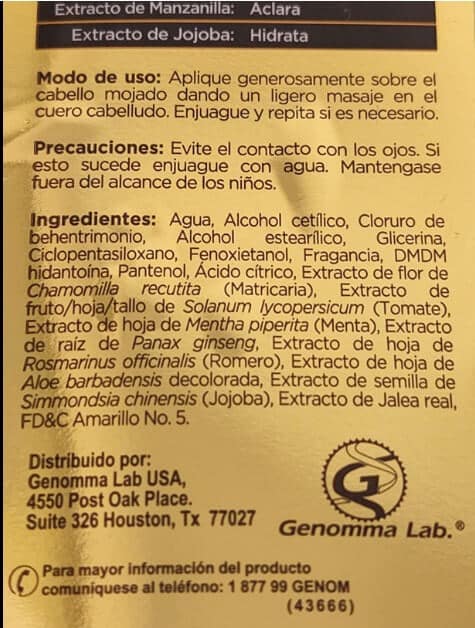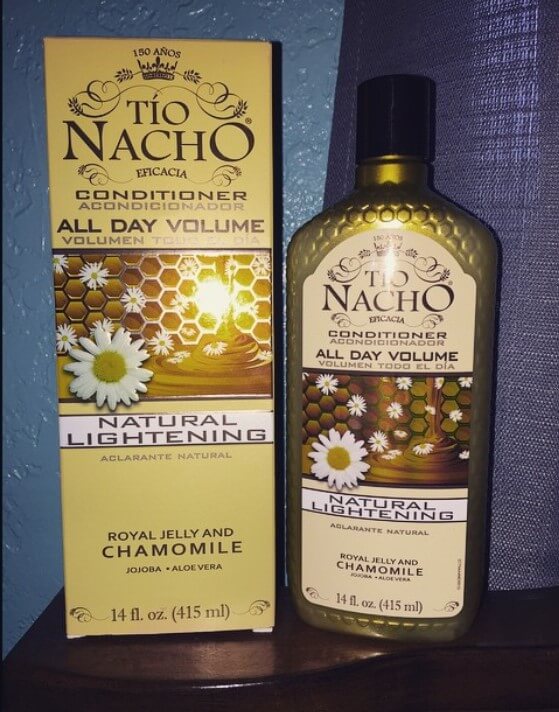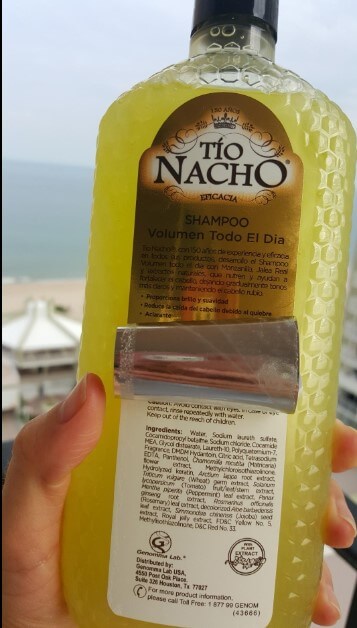See this review of the Tio Nacho Natural Lightening and Volumizing Shampoo and the top Ingredients and learn if this shampoo is good for hair.
As a hairstylist with 10 years of experience in the US, I've seen countless haircare claims come and go. But Tio Nacho's Natural Lightening and Volumizing Shampoo piqued my curiosity. I decided to put it to the test, analyzing its ingredients and seeing its effects firsthand on a diverse clientele.
In this review, I'll crack the code of each key ingredient, explain its hair-loving properties, and share the honest results my clients experienced. Get ready for a deep dive into the science and shine behind this intriguing shampoo!
Tio Nacho Natural Lightening And Volumizing Shampoo Ingredients
Water, Sodium Laureth Sulfate, Cocamide DEA, Cocamidopropyl Betaine, Polyquaternium-7, Glycerin, Sodium Chloride, Ammonium Lauryl Sulfate, Ammonium Laureth Sulfate, Fragrance, Glycol Distearate, Citric Acid, Lauramide Dea, Lauryl Glucoside, Dmdm Hydantoin, Chamomilla Recutita (Matricaria) Flower Extract, Cocamide MEA, Laureth-10, Ammonium Xylenesulfonate, Tetrasodium EDTA, Panthenol, Methylisothiazolinone, Solanum Lycopersicum (Tomato) Fruit/Leaf/Stem Extract, Mentha Piperita (Peppermint) Extract, Panax Ginseng Leaf Cell Extract, Rosmarinus Officinalis (Rosemary) Flower Extract, Triticum Vulgare (Wheat) Seed Extract, Aloe Barbadensis Leaf Extract, Simmondsia Chinensis (Jojoba) Seed Extract, Arctium Lappa Root Extract, Royal Jelly Extract, D&C Yellow No.10, D&C Red No.33

| Ingredient Name | What It Does |
| Water | Solvent |
| Sodium Laureth Sulfate | Surfactant/cleansing, Emulsifying |
| Cocamide DEA | Surfactant/cleansing, Viscosity Controlling, Emulsifying |
| Cocamidopropyl Betaine | Surfactant/cleansing, Viscosity Controlling |
| Polyquaternium-7 | |
| Glycerin | Skin-Identical Ingredient, Moisturizer/humectant |
| Sodium Chloride | Viscosity Controlling |
| Ammonium Lauryl Sulfate | Surfactant/cleansing |
| Ammonium Laureth Sulfate | Surfactant/cleansing |
| Fragrance | Perfuming |
| Glycol Distearate | Emollient, Emulsifying, Viscosity Controlling |
| Citric Acid | Buffering |
| Lauramide Dea | Surfactant/cleansing, Viscosity Controlling |
| Lauryl Glucoside | Surfactant/cleansing |
| Dmdm Hydantoin | Preservative |
| Chamomilla Recutita (Matricaria) Flower Extract | Soothing, Antioxidant |
| Cocamide MEA | Surfactant/cleansing, Viscosity Controlling, Emulsifying |
| Laureth-10 | Emulsifying, Surfactant/cleansing |
| Ammonium Xylenesulfonate | Surfactant/cleansing, Viscosity Controlling |
| Tetrasodium EDTA | Chelating |
| Panthenol | Soothing, Moisturizer/humectant |
| Methylisothiazolinone | Preservative |
| Solanum Lycopersicum (Tomato) Fruit/Leaf/Stem Extract | |
| Mentha Piperita (Peppermint) Extract | Surfactant/cleansing |
| Panax Ginseng Leaf Cell Extract | |
| Rosmarinus Officinalis (Rosemary) Flower Extract | Antioxidant, Perfuming |
| Triticum Vulgare (Wheat) Seed Extract | Buffering |
| Aloe Barbadensis Leaf Extract | Soothing, Emollient, Moisturizer/humectant |
| Simmondsia Chinensis (Jojoba) Seed Extract | Abrasive/scrub, Emollient |
| Arctium Lappa Root Extract | Antioxidant, Soothing |
| Royal Jelly Extract | |
| D&C Yellow No.10 | Colorant |
| D&C Red No.33 | Colorant |
Water/Aqua/H20
Water in most hair care products (and other cosmetics) is the chief component of the formula as it’s the solvent which dissolves all the other ingredients.
The water used in hair care products is sterile and deionized. This means there are no minerals in this water as they can interfere with the other ingredients.
Water-based hair products, especially conditioners are lighter, spread easily and help hydrate your hair if there are humectants (like glycerin, etc.) present in the formula.
Royal Jelly
Royal jelly is a substance secreted by young bees that functions as food for the Queen Bee. This substance is also edible and widely used for cosmetic purposes.
It has strong anti-inflammatory properties. (*Yanagita, Manabu et al. “Osteoinductive and anti-inflammatory effect of royal jelly on periodontal ligament cells.” Biomedical research (Tokyo, Japan) vol. 32,4 (2011): 285-91. doi:10.2220/biomedres.32.285)
So this makes it excellent for use in scalps affected by redness, irritation, and other conditions like eczema.
It is also highly nourishing and moisturizing. Some nutrients that make up royal jelly include vitamin B5 and other B-group vitamins, folic acid, inositol, vitamin c and biotin.
As it is rich in protein, royal jelly can also help boost hair growth and strengthen hair strands.
Chamomile (Matricaria chamomilla)
Chamomile is a well-known anti-inflammatory and natural lightening agent that has been used in medicine since ancient times across cultures like Greek, Roman and Egyptian.
Traditionally chamomile has been used to treat eczema on scalp, skin irritation, redness and itching. In fact, research shows that it’s almost "60 percent as effective as OTC hydrocortisone creams available in the market." (Srivastava, Janmejai K et al. “Chamomile: A herbal medicine of the past with bright future.” Molecular medicine reports vol. 3,6 (2010): 895-901. doi:10.3892/mmr.2010.377). It’s also very rich in antioxidants.
As chamomile is rich in vitamin C, its acidic properties make it an excellent natural hair lightening agent. It’s used in shampoos and conditioners (and even brewed as tea to be applied on hair) to help fade color.
No, chamomile will not lift your black hair to brown or blonde the way bleach does. But it is proven to lighten hair a shade or two to give a “sun-kissed” look

Sodium Laureth Sulfate
As far as surfactants go, Sodium Laureth Sulfate (SLES) is slightly milder and less irritating than Sodium Lauryl Sulfate (SLS).
Okay so think of this way, SLS is the worst offending surfactant which can lead to redness, dryness, irritation, etc. on skin. SLES isn’t as bad but it can trigger irritation if you have sensitive scalps, Ammonium lauryl sulfate is generally safer and mild.
While most coconut-derived surfactants like cocamide MEA, etc. are known to be safe on sensitive skin as well.
However, SLES is fantastic for cleaning your scalp of debris, dirt, excess oil and product buildup, but it can strip hair dye so it shouldn’t be used on color-treated hair.
Also, a strong surfactant can clarify your scalp, clearing the way for hair fall medication like serums, etc. to reach your follicles and help them get adequate nutrition.
Cocamidopropyl Betaine
Cocamidopropyl Betaine or CAPB is a type of cleanser that is derived from coconut oil.
It’s often used in shampoos in place of harsh surfactants like Sodium Laureth Sulfate and Sodium Lauryl Sulfate. Both of which can strip hair dye, remove moisture and irritate scalp skin.
CAPB however is milder and gentler and even has moisturizing properties.
Most sulfate-free shampoos do not lather well or clean hair very thoroughly but as the Videri shampoo contains this natural cleanser, it’s very good for removing grease and dirt from deep within your scalp without stripping it of moisture.
Glycerin
Glycerin is used in shampoos to act as a humectant. These attract moisture to your strands, hydrating them and then preventing the moisture from escaping.
This makes glycerin an excellent ingredient to use on low porosity hair, dehydrated hair, damaged hair, etc.
Hydrated hair is generally more elastic and less prone to breakage, hence glycerin helps reduce hair fall this way.
DMDM Hydantoin
This ingredient is a common preservative used in shampoos because of its fantastic antimicrobial and antibacterial properties. It prevents yeast, fungi, bacteria, etc. from growing in shampoos, especially considering most products are placed in a warm, moist environment in your showers.
However, recent studies have shown that DMDM Hydantoin releases formaldehyde which is known to cause severe allergic reactions and even lead to cancer in certain cases according to the American Cancer Society.
A lot of shampoo and cosmetic brands have recalled products that contain DMDM Hydantoin.
However, some studies claim that this preservative is only harmful if its quantity exceeds 0.074 percent which according to certain manufacturers it doesn’t.
Tio Nacho Natural Lightening & Volumizing Shampoo Review
Now that I’ve explained the chief ingredients of this shampoo, let’s get down to business. I used this shampoo for 2 weeks and I have just one word for it. Disappointing.
Sorry. But the Tio Nacho shampoo doesn’t work on dark brown or black hair. It can lighten dark blonde hair to a lighter shade of blonde I guess but nothing more than that.
Also, I did not like the formula.
First of all, it contains sodium laureth sulfate. My hair that’s already been colored and damaged doesn’t take kindly to such a strong surfactant.
And to make matters worse it also contains cocamidopropyl betaine and cocamide DEA (both very gentle surfactants on their own but very powerful together in a formula with SLES).
So yes, you will get very clean, voluminous hair. However, they are going to be dry, bushy and frizzy.
I used this shampoo for 3 weeks and my hair looks so much drier and straggly. Never again.
And no, I have dark brown hair and I really couldn’t see any difference in color at all. Maybe it would have worked if I had used it for a few more weeks but I don’t want to risk it.
If you have very oily hair that is not damaged, bleached, processed or colored. I guess this shampoo might work very well for you. But other than that I don’t see anything special about it.
Also, I was sorely disappointed to see the presence of DMDM hydantoin (a very harmful preservative), strong artificial fragrances and synthetic colorants in the shampoo.
To sum it up, avoid it if you have a sensitive scalp. Or maybe just avoid it.
I got the 415 ml bottle of the shampoo for about $9.99 online. So my only consolation is that at least it didn’t cost me a lot of money.
If you want sun kissed hair I suggest going out in the sun or using a hair dye. Some hair color brands are actually gentler than this shampoo.
What I Liked About Tio Nacho Natural Lightening & Volumizing Shampoo
- It’s very cleansing and clarifies hair very well
- It can lighten blonde hair to a 1-2 shades if used regularly
What I Didn’t Like About Tio Nacho Natural Lightening & Volumizing Shampoo
- This shampoo contains a mix of harsh surfactants that is bad for dry, damaged, and color-treated hair
- It contains DMDM Hydantoin a banned preservative
- It contains a lot of synthetic colorants and perfumes
- The shampoo isn’t very moisturizing
- The packaging is designed in a way to hide all the ingredients

My Ratings For Tio Nacho Natural Lightening & Volumizing Shampoo
| Design & Packaging | 2/5 |
| Texture | 4/5 |
| Ability to cleanse | 5/5 |
| Fragrance & scent | 2/5 |
| Price | 4.5/5 |
| Hydrating Ability | 2/5 |
| Gentleness | 1/5 |
How do you use Tio Nacho lightening shampoo?
Here's how to use Tio Nacho lightening shampoo:
1. Wet your hair: Start by thoroughly wetting your hair with lukewarm water.
2. Apply the shampoo: Dispense a generous amount of shampoo into your palm, depending on your hair length and thickness. Massage the shampoo gently into your scalp and hair, creating a lather.
3. Focus on the ends: Pay extra attention to the ends of your hair, as they tend to be drier and lighter.
4. Rinse thoroughly: Rinse the shampoo out completely with lukewarm water until no more suds remain.
5. Repeat (optional): If you have particularly oily hair, you may choose to repeat the process once more for a deeper clean.
6. Follow with conditioner: After rinsing, use a conditioner suitable for your hair type (lightening conditioners can help enhance brightening effects).
Additional tips:
- Frequency: Tio Nacho shampoo is generally safe for daily use, but adjust based on your hair's needs. Dry or sensitive hair might benefit from every other day or twice-weekly washes.
- Water temperature: Avoid hot water, which can strip your hair of natural oils and dull its shine. Opt for lukewarm water.
- Patch test: If you have sensitive skin, perform a patch test on a small area of your arm before using the shampoo on your scalp.
- Leave-in products: Avoid using too many leave-in products after using the shampoo, as they can weigh down your hair and reduce its brightening effect.
Summary
This Tio Nacho shampoo is not for me. It has SLES, a very strong surfactant and a bunch of milder surfactant that combines to make the formula too harsh on hair.
Yes, it removes dirt and grease very well and does volumize your hair. But at what cost?
I also didn’t like that Tio Nacho still uses DMDM hydantoin as a preservative when other shampoo companies are recalling products with it.
They also haven’t issued any clarification on whether the preservative is within safe limits or not.
To sum things up try using color-depositing dyes or safe, temporary dyes instead if you want the lightening effect without bleach. This shampoo isn’t worth it.

